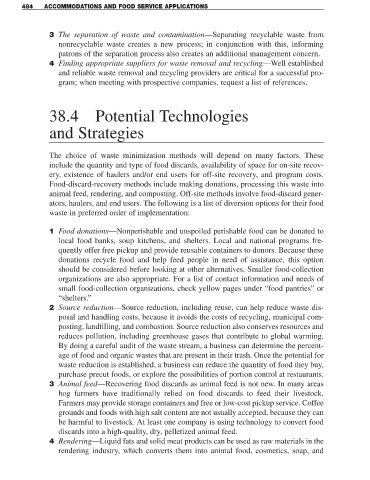Page 506 - Solid Waste Analysis and Minimization a Systems Approach
P. 506
484 ACCOMMODATIONS AND FOOD SERVICE APPLICATIONS
3 The separation of waste and contamination—Separating recyclable waste from
nonrecyclable waste creates a new process; in conjunction with this, informing
patrons of the separation process also creates an additional management concern.
4 Finding appropriate suppliers for waste removal and recycling—Well established
and reliable waste removal and recycling providers are critical for a successful pro-
gram; when meeting with prospective companies, request a list of references.
38.4 Potential Technologies
and Strategies
The choice of waste minimization methods will depend on many factors. These
include the quantity and type of food discards, availability of space for on-site recov-
ery, existence of haulers and/or end users for off-site recovery, and program costs.
Food-discard-recovery methods include making donations, processing this waste into
animal feed, rendering, and composting. Off-site methods involve food-discard gener-
ators, haulers, and end users. The following is a list of diversion options for their food
waste in preferred order of implementation:
1 Food donations—Nonperishable and unspoiled perishable food can be donated to
local food banks, soup kitchens, and shelters. Local and national programs fre-
quently offer free pickup and provide reusable containers to donors. Because these
donations recycle food and help feed people in need of assistance, this option
should be considered before looking at other alternatives. Smaller food-collection
organizations are also appropriate. For a list of contact information and needs of
small food-collection organizations, check yellow pages under “food pantries” or
“shelters.”
2 Source reduction—Source reduction, including reuse, can help reduce waste dis-
posal and handling costs, because it avoids the costs of recycling, municipal com-
posting, landfilling, and combustion. Source reduction also conserves resources and
reduces pollution, including greenhouse gases that contribute to global warming.
By doing a careful audit of the waste stream, a business can determine the percent-
age of food and organic wastes that are present in their trash. Once the potential for
waste reduction is established, a business can reduce the quantity of food they buy,
purchase precut foods, or explore the possibilities of portion control at restaurants.
3 Animal feed—Recovering food discards as animal feed is not new. In many areas
hog farmers have traditionally relied on food discards to feed their livestock.
Farmers may provide storage containers and free or low-cost pickup service. Coffee
grounds and foods with high salt content are not usually accepted, because they can
be harmful to livestock. At least one company is using technology to convert food
discards into a high-quality, dry, pelletized animal feed.
4 Rendering—Liquid fats and solid meat products can be used as raw materials in the
rendering industry, which converts them into animal food, cosmetics, soap, and

